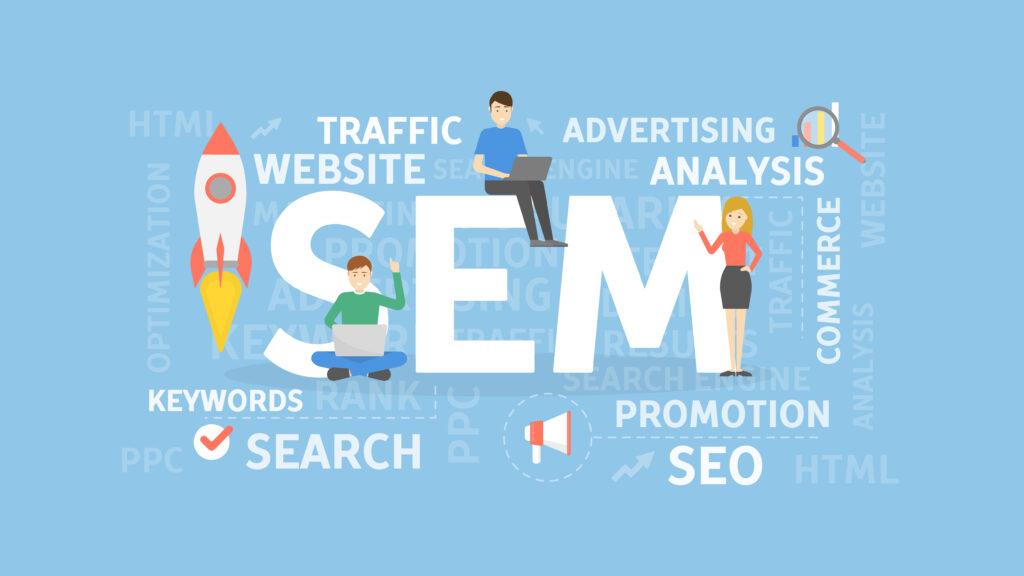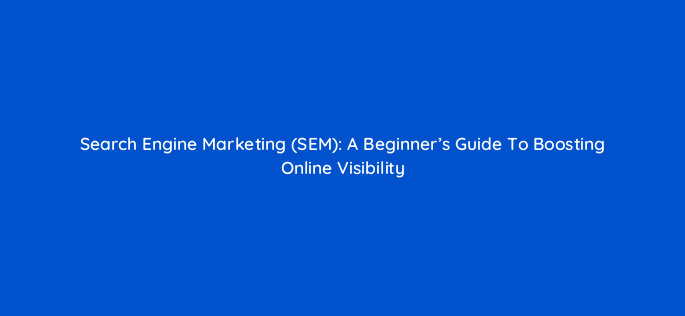Advertisement
In today’s increasingly digital world, online presence has become more crucial for businesses than ever. With over 5.3 billion internet users worldwide, you can understand why most entrepreneurs are investing heavily in their online branding. Every successful modern business has a functional website where it displays its products and engages the clients.

But simply having a website is not enough. Driving traffic to your site through effective digital marketing is key to getting your brand seen. This is where search engine marketing (SEM) comes into play. SEM refers to paid forms of search engine advertising that allow you to promote your business on search engines when prospective customers are searching for related products or services.
The main goal of SEM is to boost your website visibility in search results pages and drive more relevant traffic to grow your business ultimately. Unlike organic search engine optimization (SEO), SEM delivers instant results through sponsored placements on the first page rather than having to focus on slowly improving website rank.
While it’s a straightforward procedure, you’ll still need to invest your time and money to get the best out of it. Partnering with a reliable SEM Agency can also help you enjoy better results from your campaigns.
What’s the difference between SEM and SEO?
Although SEM and SEO serve the same overarching goal of increasing visibility, they work in very different ways. Understanding their unique approaches and strengths can help determine where to focus your efforts. Let’s take a look:
- SEM involves paid placements on search engines, while SEO focuses on organic or unpaid rankings.
- SEM delivers quicker results; SEO takes time but is more sustainable.
- SEM ads appear above or alongside organic results.
SEM should be leveraged to rapidly generate website traffic and visibility when launching a website or digital campaign. Organic SEO efforts can then be improved over time.
What are the leading SEM platforms?
Google Ads and Microsoft Advertising are the two most popular SEM platforms available. Other options include Amazon Marketing Services for product visibility and Facebook Ads for social visibility, but Google and Microsoft have the biggest reach for general website promotion for search traffic.
Key components of an effective SEM strategy
Simply signing up for a paid search account is not enough to guarantee results. There are a few core elements that make up an effective SEM approach:
- Compelling and relevant ads
Choose the right ad formats and layouts for your goals. Consider text ads with clear, concise copywriting, eye-catching brand display banners, and engaging video ads. Test different variations to see what resonates best.
- Strategic keyword targeting
Research high-traffic keywords aligned with your offerings and analyze search intent to refine targeting. Also, organize keywords into ad groups around topics and bid appropriately on these keywords based on value.
- Landing page quality and experience
Your ads’ landing pages should be clear and easy to use with reliable site speed and navigation. They must display relevant products or services prominently. Including trust signals like security badges can also improve customer experience and loyalty.
- Conversion tracking and analytics setup
Install tracking pixels and tags to collect data that’ll help you gauge your performance. Identify key conversion goals like sales or leads, measure KPIs for engagement, and provide insights to refine the campaign approach.
Tips and best practices for SEM beginners
Getting started with a paid search can feel overwhelming, with so many moving parts to coordinate. Here are some best practices to help launch and refine your first SEM campaigns:
- Start small and scale up
Test promising tactics in the market before betting big, so a small budget will show what works. Once ROI validates the winners, increase investment behind success.
- Review analytics frequently
Analyze how your paid ads are performing: clicks, click-through rate (CTR), conversions. Attribute insights to specific keywords, ads, and pages to critically assess where to double down.
- Use negative keywords
Flag irrelevant search queries to limit accidental clicks that do not convert. Tightening targeting through negative keywords improves campaign relevancy.
- Write quality ad copy
Compelling ad copy stops the scroll. Emotional hooks set the stage, while clear, concise copy and sharp calls-to-action seal conversions.
- Incorporate retargeting ads
Remarket visitors who previously left to give conversion another chance. Layering retargeting expands exposure.

Conclusion
Implementing an effective search engine marketing strategy requires the coordination of multiple key components: compelling and relevant ads, strategic keyword research, high-quality landing pages, and dialed-in analytics. While initially may seem complex, starting with a limited budget and scaling while optimizing efforts based on performance data will pave the path for long-term SEM success.
Subscribe to our mailing list and get interesting stuff and updates to your email inbox.
